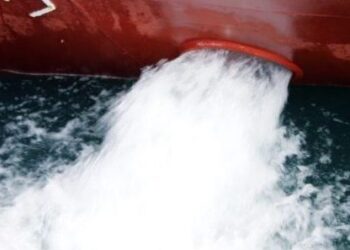West of England P&I Club informs that its correspondents Liquidadores, Buenos Aires, have advised about demands being made by the Sanitary Authorities at the Port of San Lorenzo, Argentina, for vessels, to produce a certificate of chlorination pertaining to the ballast waters on-board.
The demand concerns ballast water treatment for vessels arriving from foreign ports and came into force on 24 February 2017, under the Ministry of Environment and Sustainable Development ratification of Resolution 85-E/2017. The resolution is a preliminary stage to the International Convention for the Control and Management of Ships’ Ballast Water and Sediments, to which Argentina is party by Act 27.011/2014 and will enter into force on 8 September 2017.
In accordance with the new regulation, vessels calling at Argentine ports must apply a chlorination treatment to their ballast tanks, as a measure to counteract the potential inception of intrusive aquatic species that could affect river ecosystems in Argentina. The Ministry of Health and Social Action Resolution 159/99 establishes a proportion of chlorine to be applied of 15 parts per million.
However, West P&I informs, it remains unclear as to who should chlorinate the tanks, as the current regulation only stipulates that it must be done at roads on arrival, but does not clarify whether it can be undertaken by the crew or a local entity. There are however reported ship’s agents at the Port of San Lorenzo supplying chlorine to vessels allowing the crew to perform the chlorination and for the Master to issue the certificate as per Section 2 of Resolution 85-E/2017.
West Club highlights also the two other primary regulations addressing ballast water treatment, which have been in force for many years:
- Coastguard Regulation 7/98: All vessels arriving from foreign ports must deballast before entering the Rio de la Plata. This regulation refers to an area determined by the treaty between Argentina and Uruguay regarding the maritime boundary in which there is an absolute prohibition against deballasting. This area is determined by four waypoints as follows: Punta del Este – Uruguay/latitude 36º 14′ S longitude 53º 32′ W/latitude 37º 32′ S longitude 55º 23′ W/Punta Rasa (Argentina). Further, according to the regulation, a salinity level lower than 30 parts per thousand (30 milligrams per cubic centimetre) in the ballast water will not be accepted after being changed. If the measurements made on the samples indicate a lower salinity level, the ballast water exchange operation will be considered not to have been performed satisfactorily or to have been carried out too close to the Rio de la Plata.
- Coastguard Regulation 12/98: It establishes certain protected areas in southern Argentina (Patagonia) where deballasting is prohibited. Although the new regulation makes no reference to ballast water exchange, it does specify that Regulation 7/98 which necessitates ballast exchange must be followed. The Argentine Naval Prefecture is expected to review its own regulations following the rules from the Ministry of Environment and Sustainable Development to bring more certainty to deballasting operations.
West Club anticipates that local authorities at other Argentinean ports will follow the precedent set by the Port of San Lorenzo of requesting the certificate of chlorination and advises operators to seek instructions on all ballast water management matters from their local agents prior to the vessel’s arrival.
Source: West of England P&I Club






























































